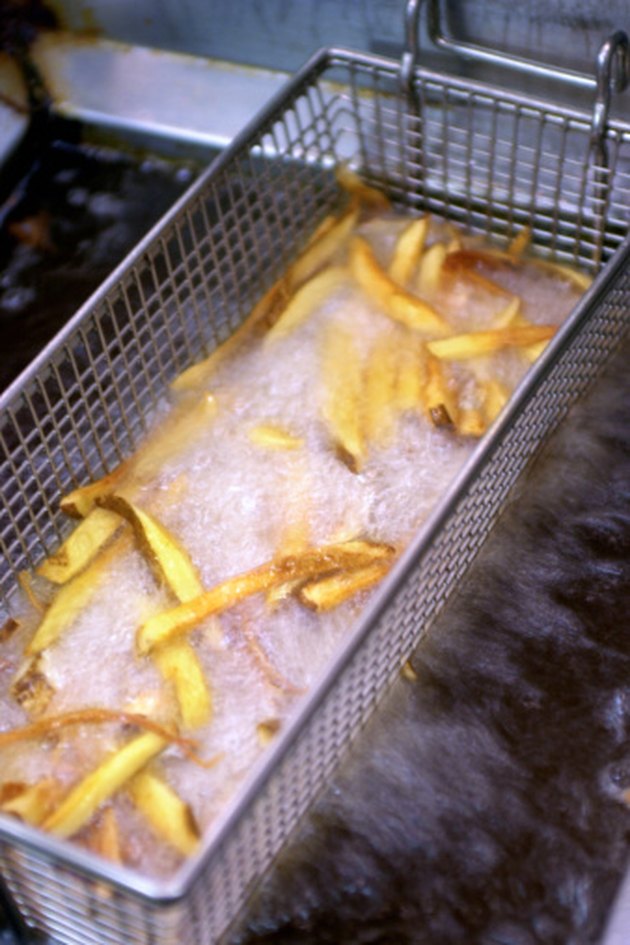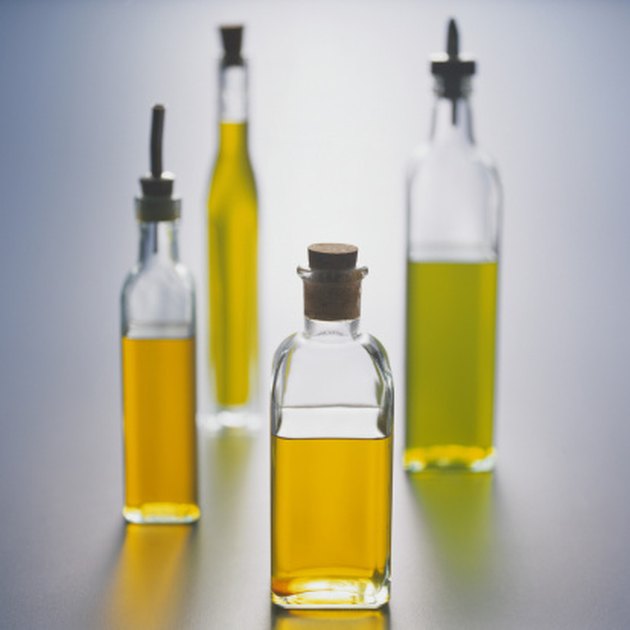Vegetable Oil vs. Sunflower Oil for Deep Frying
To produce the best deep-fried foods, cooking temperatures should be about 375 F. This quickly cooks the outer coating and keeps the oil from absorbing into the food and making it greasy. Cooking oils used in deep frying should have a high smoke point. The smoke point is the highest temperature to which the oil can be heated without smoking and before it starts to break down.

About Cooking Oil

There are many varieties of cooking oils, which vary in the ratios of saturated, polyunsaturated and monounsaturated fats they contain. Some are derived from animal sources, while most are made from plants, nuts or seeds. Oils can contain different types of fats, such as unhealthy fats that can raise cholesterol levels and healthier versions that help decrease the risk of coronary artery disease. All fats contain nine calories per gram, twice the amount of calories as carbohydrates and protein.
Unhealthy Fats
Saturated fat is usually found in oil derived from animal sources but is also found in coconut butter and oil and in palm oil and is solid at room temperature. These fats raise total blood cholesterol and low-density lipoprotein (LDL) cholesterol levels. A diet high in saturated fat increases your risk of cardiovascular disease and type 2 diabetes.
Trans fat is a result of adding hydrogen; known as hydrogenation, to an unsaturated fat to increase stability of the oil and ease of cooking. These fats can also increase LDL cholesterol and decrease HDL (high-density lipoprotein) cholesterol.
Healthier Fats
Polyunsaturated fats and monounsaturated fats are usually found in plant-based oils and are liquid at room temperature. Using these oils instead of saturated oils can improve blood cholesterol levels, thereby reducing the risk of cardiovascular disease and type 2 diabetes. Omega-3 fatty acid is a polyunsaturated fat found in some types of fish, such as salmon, mackerel, herring, lake trout, sardines and albacore tuna, and is beneficial in reducing your risk of heart disease.
Vegetable Oil

Oil marketed as pure vegetable oil is usually made from soybeans. Soybean oil is one of the most widely used inexpensive oils. It is low in saturated fats, contains no trans fat, is high in polyunsaturated fats and contains monounsaturated fats. It is also a source of Omega-3 fatty acids, as well as Omega-6 fatty acids, both of which may decrease the risk of heart disease. Soybean oil is a primary source of Vitamin E and has a smoke point of 450 F, making it stable for deep-frying foods.
Regular vegetable oil, not designated as pure, is a blend of different refined oils. This oil usually has a high smoke point, but it may be difficult to determine which oils are included.
Sunflower Oil

Sunflower Oil, pressed from sunflower seeds, is light, odorless and mild in flavor. This oil supplies Vitamin E, is low in saturated fat and contains both polyunsaturated and monounsaturated fats. High oleic sunflower oil is high in monounsaturated fats and is defined as 80 percent oleic acid. Refined high oleic sunflower oil has a smoke point of 450 F. Linoleic sunflower oil is high in the polyunsaturated fat linoleic acid, an omega-6 fatty acid. The stability and high smoke point of high oleic sunflower oil makes it a good deep-frying oil.
Choosing Between Vegetable Oil and Sunflower Oil
Both oils have high smoke points, which is important when deep frying foods, and are low in saturated fats, which is important in reducing the risk of heart disease. Vegetable oil may be less expensive and more readily available than sunflower oil. People who are allergic to, or want to eliminate, soy from their diets should avoid vegetable oil. Sunflower oil should be avoided by those with sunflower seed allergies. Taste may be the determining factor in choosing which oil is right for your deep-frying needs.

